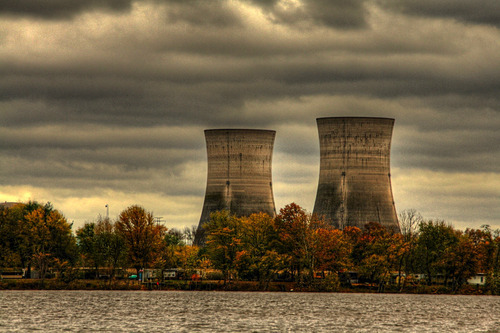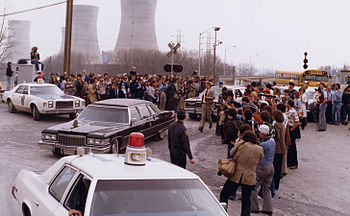American Evangelicalism and Nuclear Energy
When I was a young boy, my dad loved taking me fishing. In fact, I loved the time with him as well. Often we would travel approximately 20 miles and launch our boat on the Susquehanna River. One of our favorite fishing holes was located about two miles from the launch, it was known as Three Mile Island. Yep, you heard me right! Three Mile Island, the nuclear power plant. The one that on March 28th, 1979, had a partial nuclear meltdown. I remember my mom coming and getting my off the swing-set and pulling me inside the house. It was the worst accident in U.S. commercial nuclear power plant history. A partial meltdown occurred because a simple pilot-operated relief valve was stuck open. What was once a great place to fish, be with my dad and enjoy life, now became a very toxic place.

This past week while reading article submissions on “Respectful Conversation” A Project Hosted by Harold Heie I was reminded of my heritage growing up in American Evangelicalism. These writings along with my memories emerged a few key strengths as well as weaknesses immersed within the framework of this movement. While reading, I couldn’t help but draw upon the parallels between nuclear energy and American Evangelicalism. Mainly in its potential for good as well as disaster. The following are a few key weaknesses and shifts which are occurring.
Key Weaknesses
Lack of Contextualization & Diversity… We live in a globalized world. Global realities find their way into our homes, workplaces and the everyday life. Some regions in the U.S. are known for their global trade, impact and diversity, such as New York and Los Angeles. Yet, much of the U.S. is made up of smaller communities locked into very specific heritages and cultures. Living in New York City, your neighborhood street may contain people from 10 varying ethnicity and all you need to do is walk out your door to understand a broader global perspective. While another living in Iowa, the center of the country, may need to drive 1000 miles or two days to find someone who is not immersed in the exact same culture. American Evangelicalism thrives in the second of these two. Often in places where traditional norms are not being challenged and diversity is seen as something to avoid.
American Pride… Alive and well in American culture is still an imbedded principle that what we do is better. Or, some would even say, right. Now, this idea is completely wrong and a false belief. However, this same mindset is parallel in American Evangelicalism. A subtle pride within this movement often approaches matters of theology and methodological practice as there is only one right way, and that way is theirs. Growing up, I watched hateful church meetings, multiple church splits and families divided over absolute non-sense stemming from a truncated formation in American Evangelicalism which often left its followers operating from an emotional adolescent or childlike state. While at the same time saying, “We’re doing this for Jesus.” I heard it said before, “Pride keeps us from truly seeing ourselves for who we are, who God is and loving our Neighbors as ourselves.”
Key Shifts
Phase One… Over the past nine years of teaching, I have seen three major shifts in the North East within American Evangelicalism. In the fall of 2005, students were jaded. Having watched the last 10 years of American Evangelicalism fight, follow poorly contextualized rules and marginalize disciple making and missional living, they were simply done. They loved Jesus, but hated the church. And they hated American Evangelicalism.
Phase Two… Shift number two brought about another type of student. In this movement, students weren’t jaded but they also weren’t connected. This group was known for their ability to love others well and live missionally minded. This group unlike the last group didn’t hate American Evangelicalism, they simply didn’t care about it. The movement was largely seen as marginalized and non effective, so why bother, just go do your thing. During this season, I could have taught Jesus came from Mars, handpicked his disciples from Venus and was eventually crucified on Earth, and no one would have had a problem with it. As long as I said, “Go live missionally.”
Phase Three… Shift number three is my current season. This season is reflected by an adamant return to the tradition stances and views of the American Evangelical movement. Not subtle in any way, a reactionary form of American Evangelicalism is trying to regain their place of prominence. Two key characteristics of this modern movement are the same weakness I’ve seen from the past. A lack of contextualization and diversity within the overall understanding of theology and methodological issues, as well as, a very overt pride lacking compassion towards fellow brothers and sisters in the faith.
What I am coming to understand about our Global world is that shifts are beginning to happen faster and faster. The lifespan of any movement has a shorter half life in this global fast paced society. Hyper American Evangelicalism will give way to another trend. My question for each of us is, “How will we plant the seeds for the next shift, guiding our little portion of the kingdom towards a healthier balance of Mark 12?”

33 years later, my dad and I went fishing by Three Mile Island last year. It’s all safe and clean again, but we certainly don’t forget what happened on that crazy day in March of 1979.
Leave a Reply
You must be logged in to post a comment.